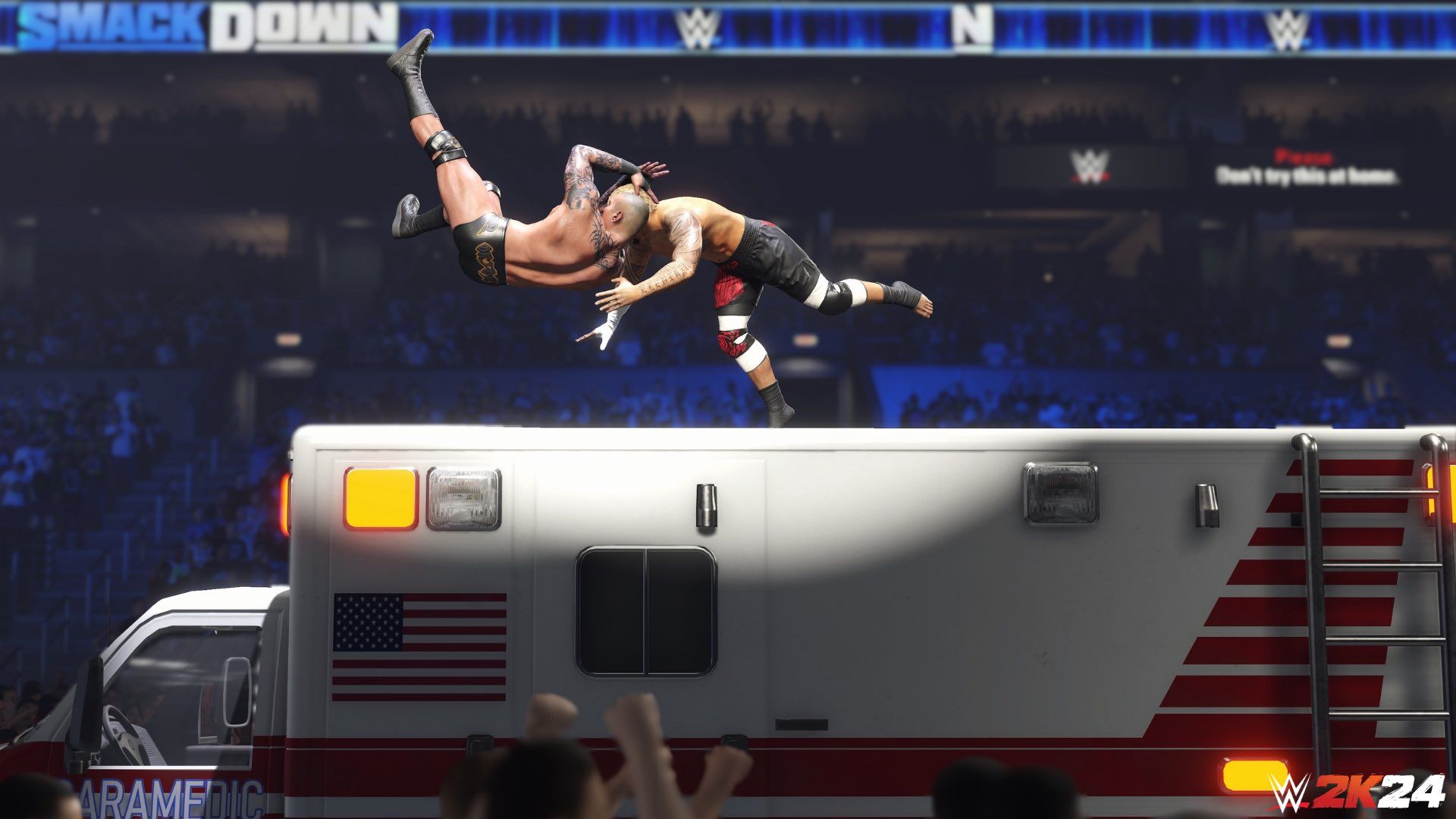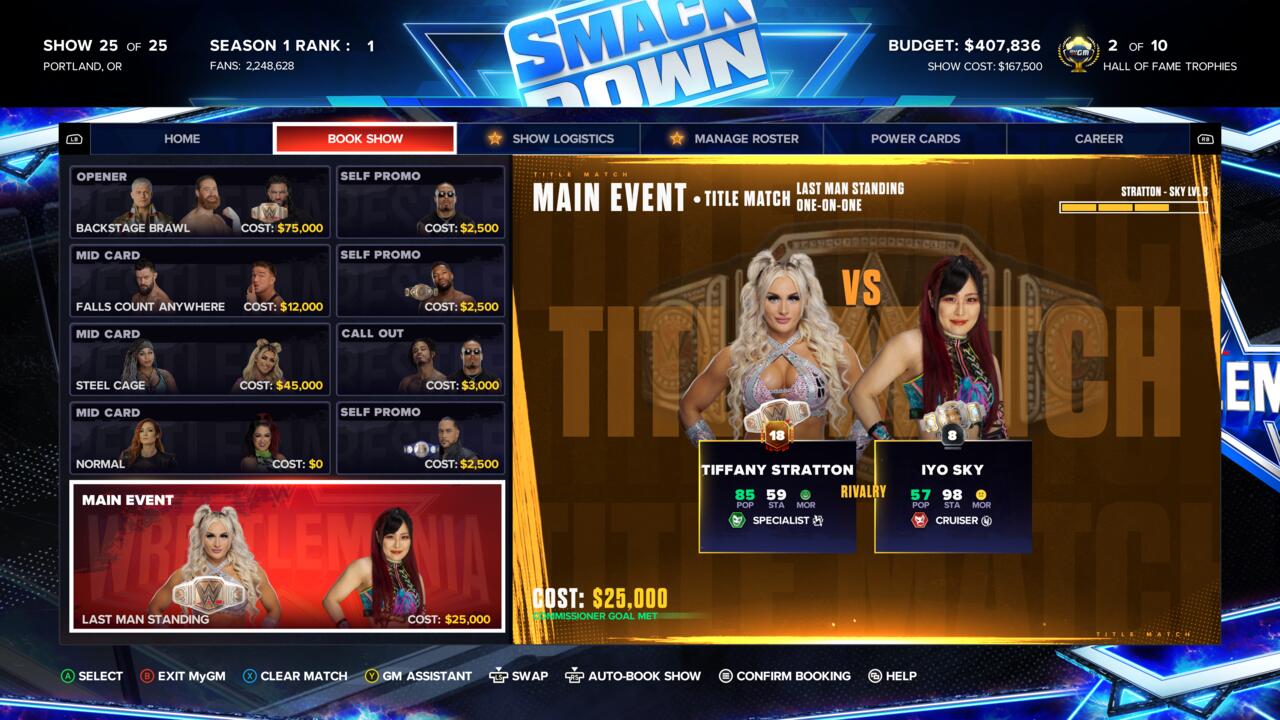The WWE 2K series has had a multi-year arc not unlike something you’d see watching WWE’s shows on TV. Its 2020 installment was so broken, poorly received, and ultimately meme-ified that the team actually took a year off to fix its jobber-esque series–a rare sight in the world of annualized video games. But since then, it’s been on the rise, getting pushed like a WWE superstar to the top of the card, and though WWE 2K24 doesn’t yet finish the story, it seems like it’s well on the path of cementing a new legacy for itself.
WWE 2K24 adds appreciable, albeit not revolutionary, improvements to last year’s solid foundation across the board. The in-ring action is paramount, and WWE 2K24 thankfully builds on the already-excellent mechanics in that regard. There’s more fluidity to chaining moves together, and it feels like, at any point in which your character has the upper hand, you can reliably emulate the escalation of a real-life match, with a deep assortment of move sets depending on where you are in the ring. An intuitive control scheme lets you set up a rival sitting atop the turnbuckle, staggered on the ropes, or lying on their back in the middle of the ring for an ankle lock with similar ease. The game simply always feels great to control.
Pairing those contextual attacks with a deep move set for every wrestler in which the left stick and face buttons combine to create excellent variety, 2K24 feels like it rolls out much of what made 2K23 already fun in my hands, but with a few new touches that I enjoy. This includes top-rope maneuvers onto a group of opponents rather than just one; Super Finishers, like Rhea Ripley’s belt-winning Riptide from the second rope at last year’s WrestleMania; and the ability to throw weapons. These are subtler changes than the complete overhaul the series received when it emerged from its darkest days a few years ago, but they’re each welcome to the game and help further emulate the real-life product.
One thing the in-ring action still needs to be fixed is the way wrestlers can warp to complete animations, particularly during top-rope maneuvers. In real life, when a superstar goes to the top rope before a dive attack of some kind, what you don’t usually see on TV (due to the cameras purposely hiding it) is how the wrestler receiving the attack will shift their body to help their rival perform the move safely–this avoids things like knees to the head or groin, for example. But WWE 2K’s top-rope maneuvers still include a lot of awkward warping of the leaping wrestler to stick the landing. This is not only backward from reality, but often looks janky. This has been in wrestling games for years, and though 2K24’s in-ring action is overall excellent, these moments do betray the otherwise commendable level of realism.
The wrestlers themselves usually look good or even great, albeit with the long-present issue of long hair behaving erratically once again rearing its head. The degree of how authentic an in-game model of a WWE superstar looks rises and falls in step with how long their hair is. Baldies like Kurt Angle and Stone Cold Steve Austin look excellent. Short-haired folks like Cody Rhodes and Rhea Ripley benefit from their less-than-luscious locks, and the longest-haired wrestlers like Becky Lynch and Roman Reigns tend to express the most jank atop their domes, with strands often flailing around unrealistically or clipping through their clothes. Like the warping top-rope maneuvers, hair is a long-standing problem in WWE games.
The roster has now ballooned, welcomely I should say, to 200+ current and past talents. Almost anyone you would expect who is not tied up in real-world issues–like being on another brand or otherwise scrubbed from wrestling’s all too commonly shady history–is present. A few big current-day talents are sorely missed, but in most cases, they seem to be tied to late arrivals to the brand during the game’s dev cycle, such as CM Punk, Naomi, and Jade Cargill. Punk has already been announced as a DLC character, which stings given how important he is to the roster. Naomi and Cargill may one day be on that same tier, but for now, I find their inclusion as DLC characters to be more acceptable and in line with past WWE DLC packs. Punk, however, feels like he should come via a free update.
Several gimmick-heavy match types have been added, including ambulance, casket, special referee, and gauntlet matches. These match types have been present in some past wrestling games, and I think their returns are worthwhile. Though I don’t feel a strong fondness for any of them except special referee–which allows for some hilarious multiplayer betrayals–it’s nice to have them all back, mostly for some of the game’s longer-tailed modes or PvP online where usually everyone wants to put on something more than a standard exhibition match.
Nearly every game mode has improved, but for me, it starts with GM mode. It gamifies running the business more than actually fighting the matches, though that’s an option for those who want to do both. In 2K24, GM mode is awesomely deep. Signing free agents now uses a scouting system in which you hone in on the type of superstar you want–say, an established star working as a brawling babyface in the women’s division. It costs money to do this, so you’re motivated to have a plan, because ideally, you’ll spend money to identify someone who fits your needs, and then sign them on the spot.
You can acquire superstars via other new means too, such as trading with rival brands after each premium live event. I’ve not found the CPU offers me trades I want to execute, but I can initiate my own, and I honestly think I was universally opposed to their offers because I get so attached to my roster and the stories I’ve created. Still, it’s nice to be able to offer cash for wrestlers in trades, like contract buyouts, letting me lose no personalities in the exchange.

The mode’s economy is also fleshed out with an overhaul of how you improve the production of your show. Before, you’d need to spend money per show to improve things like the pyrotechnics or lighting, but now you save up to permanently unlock these over the course of the GM mode’s multi-season, multi-year arc. I prefer it, because while spending on scouting and trading makes the mode more money-hungry in other ways, it feels like increasing the production value is ultimately less costly and balances out some of that spending, which, by the way, is never done using paid currency, thankfully.
Each superstar in GM mode also now has their own skill level that you upgrade by putting them to use. It essentially measures how good they are in the ring, and they’ll unlock new match types for you to use across your show as they level up. This combines with the previously established popularity and stamina systems to help guide (and challenge) your booking as you seek to be the best weekly product in the WWE machine. I’ve always loved drafting my superstars, creating rivalries, and telling stories over many months just like I see on television, and the new skill system adds more ways for me to feel like I have a clear direction for my show. When I strapped the proverbial rocket to Tiffany Stratton, improving her in-ring work and her popularity with the fans, her value to my show was obvious and rich with rewards, both monetary and otherwise.
For those who want a less business-focused sandbox in which to play, Universe mode returns and is, like GM mode, better than last year’s, though its new toys aren’t as important as GM mode’s. Universe mode is designed as the ultimate WWE simulation, allowing you to book every show, every week, make roster decisions, tell stories with new in-game mechanics you play out like run-ins and post-match beatdowns, and essentially pour over every aspect of the WWE name.
I love the addition of double title matches since this is something common in real life that wasn’t available until now. You can also perform Loser Leaves Town matches as a way to write a superstar off your show for some time or even permanently. Like GM, Universe mode asks you to bring some headcanon to the mode–a rivalry has an in-game metric, but you don’t actually see the promos being cut, so it’s best enjoyed by the players already in deep with wrestling as their weekly hobby who enjoy fantasy booking. With unique mechanics like momentum and power rankings, it scratches a different itch from GM mode even as they both appeal, at the highest level, to players who want to book matches like they’re heading up the creative team.
GM and Universe modes are heavy on player-driven and emergent narratives, but for players who prefer their storylines to come scripted like an episode of Raw or Smackdown, MyRise returns with two new storylines and some nice touches to both. The Undisputed and Unleashed storylines offer players story modes in the men’s and women’s divisions, respectively. They both benefit from a lot more voice work this year, which can vary in quality, but since these are wrestlers and not, say, football players, the delivery isn’t usually distractingly bad and sometimes it’s even good.

Better than the voicework is a new side-questing system that allows you to work shorter programs with rivals off the main path, like briefly feuding with Kevin Owens in exchange for a permanent skill increase before you return to your mainline feud regarding the WWE Universal Championship. The rewards are so worthwhile that I skipped none of them in my playthroughs.
Of the two stories, the women’s storyline is more compelling. It sees you start as a Face That Runs The Place-type of star for an indie promotion before you get poached to the big leagues of WWE. I love indie wrestling and attend shows often, so I found myself smiling at how well these cutscenes painted the picture of such a show. It’s meant to have an ECW-like quality to it, and the story drills that home with a small but raucous crowd and the DIY nature of the entire promo. The men’s story is good too, but its focus on a mid-carder finally getting their push to main event status is just inherently less interesting since it feels much more commonplace in reality.
For the best scripted storytelling in the game, Showcase mode is where to spend your time. Like when NBA 2K revisited its concept of a Michael Jordan legacy mode, WWE 2K foregoes spotlighting a single superstar and opts instead to run back the Wrestlemania-centric Showcase mode it previously attempted 10 years ago. 21 matches across four decades are given the Showcase treatment, which this year includes narration by WWE commentator and former in-ring star Corey Graves, lots of archival footage, and a few talking-head segments with folks like Hulk Hogan and Kurt Angle. I wish there were more interviews to contextualize each match by the people who lived it, as there seemed to be too few even once the mode carries into the modern day where wrestlers are still alive to speak on their matches.
On the bright side, the stylish delivery of Showcase mode returns for a third consecutive year. The matches seamlessly transition from in-game action to live-action footage from years gone by. It never gets old, and I found myself routinely mesmerized by how the matches would blend gameplay and real-life footage. The result is a playable Wrestlemania documentary that caught me up on some of my historical blind spots.
A lot of what makes WWE 2K24 is its best-in-class creation suite, which further separates itself from the field with create-a-referee and an immediately meme-heavy create-a-sign. The WWE 2K community is incredibly dedicated to bringing in every famous face not there today using create-a-wrestler, like MJF, Sting, and Guilia, to reviving old shows like WCW Monday Nitro in create-a-show, to even creating custom championship belts or Money In the Bank briefcases.
The tools run so deep that every creation sub-suite is full of amazing content for the larger community to enjoy thanks to the work of a small percentage of players. With all of these tools, it’s entirely possible to use WWE 2K24 to play out entirely different brands like NJPW or AEW, unofficially making it the best game based on those brands, too. It’s truly astounding. A lack of custom music continues to hinder the mode slightly, but I sense this is due to the complexity of music rights in the streaming age, so even as its absence is felt, it’s also forgivable.
MyFaction returns as the card-collecting live-service mode meant to keep players logging in daily for XP rewards and the lure of spending real money. Given how much else there is to do in 2K24, it feels like an afterthought to anyone but the mode’s already-established fans. MyFaction uses similar progression loops as counterparts in other games like Madden Ultimate Team or NBA 2K’s MyTeam. It’s rife with predatory and uninspiring economies where you can slowly grind through ladders of endless content to marginally improve your faction of superstars, or quickly buy randomized card packs for real money and enjoy much faster gains.

There are ways to target specific superstars and ensure you get what you want, but both the grind of the mode and the dizzying nature of its four separate currencies leave a bad taste in my mouth. I don’t have any desire to engage with my faction, The Fudgement Day, beyond what it took for me to review this aspect of the game. Like most sports games doing this kind of content, it feels like meaningless busywork, where the reward is not the gameplay, but watching the numbers in the menu get bigger.
It’s meant to activate some probably intensely researched parts of our brain where we’re compelled to repeatedly run these mazes to find crumbs of cheese at the end, spending money as we go, and my only hope–since this mode is still relatively new and not as embedded as it is in Madden or EA FC–is that the WWE 2K team can drop this mode or outsource it, thus freeing up more time for meaningful parts of the game. It’s already doing so much so well, and yet MyFaction’s disappearance would be an addition by subtraction for the series.
It was last year’s WWE game that rekindled a years-absent obsession for pro wrestling within me. I’d not be writing this review if that game weren’t impressive, and so as a rejuvenated fan of the medium, I’ve been elated to see how this game improves on the high bar set last year. As both WWE and the wider format of pro wrestling live through a new golden age, it’s fortuitous timing for fans that this year’s game is so great. While the MTX-heavy mode feels tacked on like a publisher mandate, there are thankfully several other modes that each feel like they deserve to be played for many months ahead, making them the true centerpieces of your personal WWE universe.